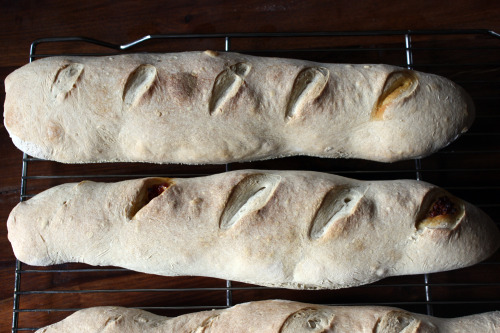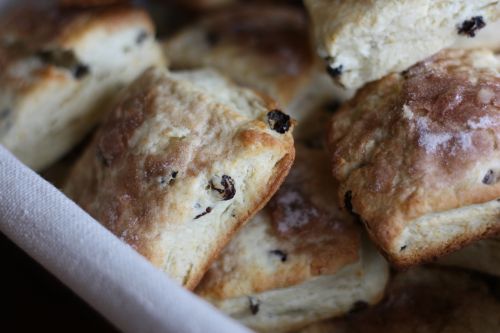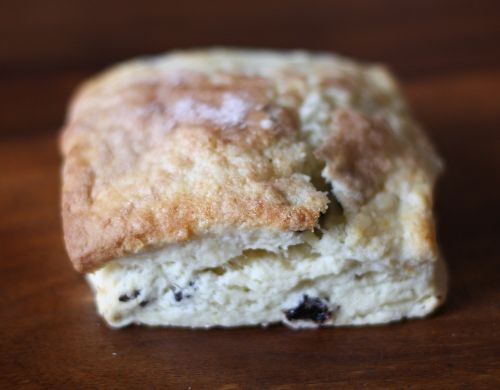If I happened upon this blog and saw this photo, I would assume it was biscotti. You know, when you take the log from the oven to start slicing it into cookies. It is not biscotti; it is bread. Bread that did very little rising. Why? I’m really not sure. This is why people are afraid to work with yeast. Yeast can be mysterious. I have a feeling that it just wasn’t warm enough in my kitchen for it to do its thing. Usually when I am baking bread, I turn on my oven to a very low heat and then turn it off and prop the door open for a minute or two. That nice little warm haven is perfect for rising dough. I skipped that step this time.
Why am I sharing a recipe for flat bread that is not supposed to be flat? Simple. It tasted really good. Like if it had risen appropriately, I might have found my perfect bread. I am a total sucker for olives and absolutely love them in bread. For this particular recipe, you make a Biga starter which is nothing more than some flour, yeast, and water. You will have more starter than you need for one loaf, so why not double the bread recipe and make two? Put one in the freezer and one on your table. And if yours rises, send me a photo.
One Year Ago: Roasted Orange Pepper Soup
Olivetta Loaf
Macrina Bakery and Café Cookbook
Makes 1 oval loaf
The recipe originally suggests you bake this bread on a pizza stone. I found the dough so wet and sticky that I would have been unable to get it onto the stone. It also suggests you do a final shaping step that I was also unable to do due to stickiness. Just keep your flour handy, do what I did, and the bread will taste great.
5 ounces Traditional Biga Starter (recipe follows)
1 cup water, at room temperature
¼ tsp. dried yeast
2¾ cups all-purpose flour
1/3 cup olive oil
1 tsp. chopped fresh rosemary
1 tsp. chopped fresh oregano
2 tsp. kosher salt
¾ cup green olives, pitted and halved
Combine starter, water, and yeast in the bowl of a stand mixer. Using the paddle attachment, mix on low speed for 1 minute. Add flour, ¼ cup of the olive oil, herbs, and salt, and mix on low speed until ingredients are combined. Switch to the dough hook attachment and mix on medium speed for about 10 minutes. Dough will start forming a ball around the hook.
This dough is quite wet, so give your hands a generous dusting of flour before working with it. Pull dough from bowl on to a floured surface and form into a 6 x 10-inch rectangle, positioning dough so that a short end is facing you. Sprinkle olives over entire surface of dough. Starting with the closest end, roll dough away from you into a log. Make sure log is resting on its seam, then fold the ends underneath to form a loosely shaped ball. Place ball of dough in an oiled medium bowl and cover with plastic wrap. Let proof in a warm room, 70 to 75°, for 2 to 2½ hours. Dough should double in size.
Pull dough from bowl onto a floured surface and gently flatten it with your hands to release excess air. Form flattened dough into an oval shape by folding the left and right sides onto the top. Place loaf, seam side up, on a very well floured floured rimmed baking sheet. Sprinkle top of loaf with flour and cover with a dish towel to keep it from drying out. Let proof in a warm room for about 1½ hours. Loaf will rise slightly and be soft to the touch.
While loaf is proofing, preheat oven to 385°F.
Uncover dough dimple lightly with your fingers, and place baking sheet in oven. Bake for about 45 minutes. The finished loaf will have a reddish brown color and will sound hollow when tapped on the bottom. Let loaf cool on a wire rack for about 20 minutes, then brush top with more olive oil.
Traditional Biga Starter
Makes approximately 2½ pounds of starter
2 cups water, at room temperature
1½ tsp. dried yeast
2½ cups flour
Pour water into a medium bowl and sprinkle yeast on top. Mix with a whisk until all lumps are dissolved. Add flour and mix with whisk until smooth, about 3 mintues. Place uncovered bowl in a warm room, 70 to 75°, and let sit for 2 to 3 hours. Bubbles will appear on the surface of the biga.
Cover the bowl with plastic wrap and transfer to the refrigerator for at least 6 hours. It is during this time that the starter will truly develop its flavor. Bigas can be stored in the refrigerator for up to 4 days. So it does not taste too sour, it is best to use it within 2 days.

 Share
Share





